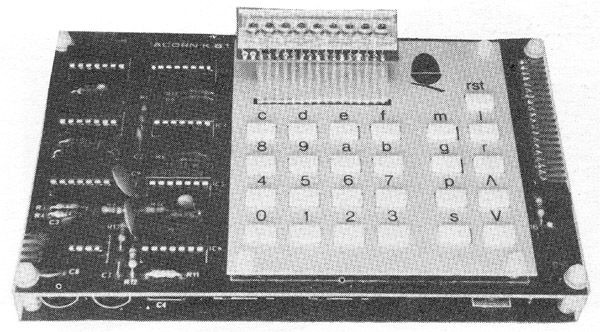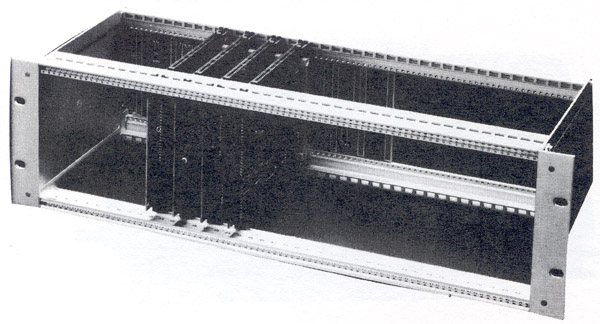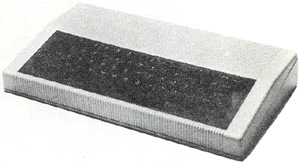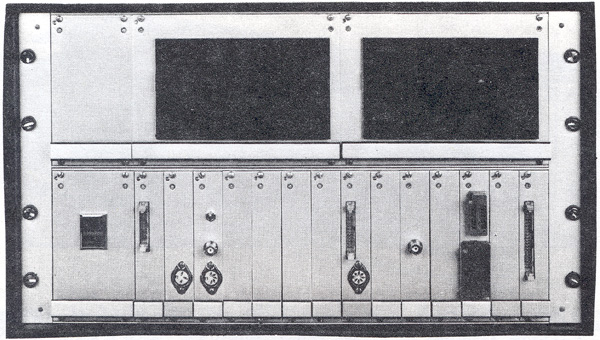|
The Acorn Atom pre-history
Thanks to Jon Dane, founder/owner of Control Universal Ltd. for this piece of information.
Before making consumer oriented computers Acorn made industrial and
educational systems. The optional keyboard for these systems is very
similar or identical to the Atom case. So it was only a small step to
integrate the electronics of CPU, VDU and memory card into one board
with the keyboard and create the Atom.
The pictures and text below are from the Control Universal Ltd.
catalogue. Control Universal started as an AIM65 reseller and sold
the Acorn cards as extensions for the AIM. When Acorn hit success
with the BBC Computer they sold the industrial card business to
Control Universal. This company eventually designed and made the
"EuroBEEB" which was a 6502 eurocard with on-board BBC
BASIC that allowed the use of graphics and analogue and digital i/o for
industrial control purposes.
System 1

| |
The System 1 has a 6502 processor Eurocard (100 x 160 mm) , crystal control ,1K bytes of
RAM and 512 bytes PROM containing a system monitor. A second Eurocard is
mounted above it using pillars the two are connected by ribbon cable.
The top card has a click action 25 key hexadecimal keyboard and an eight
digit seven-segment LED display.
The system monitor contained in two fusible link PROMS(74S571) is very easy
to use and provides the following facilities using one of the 8154 devices
as a keyboard interface and display driver.
|
System 2


| |
The System 2 provides the basis for the addition of more Eurocards. The system 2
contained within a 19" card frame consists of Eurocards all of which are described individually in a catalogue.
6502 CPU (code 720)
This is a crystal 6502 processor card, with a 2K byte Cassette Operating
System (COS) and a keyboard interface.
VDU Interface (code 740)
- 40 column x 25 lines, 8 colours including black and white.
The COS provides drivers for display of text and graphics and hardware
scrolling.
MEM0RY BOARD (code 735)
Carries 4K bytes of RAM (a further 4K may be added) and the 4K BASIC ROM.
A second ROM containing a floating point package and scientific functions
may be added. Customers may specify CPU-MEM as an alternative to this memory
card, at no extra cost.
CASSETTE INTERFACE (code 935)
Using this board, programs and data may be stored on an audio cassette recorder.
The four boards are connected in the card frame using an 8-slot backplane
with two part Eurocard DIN connectors.
Please note that a keyboard is usually required for this system.
|
System 3

| |
The system 3 in its minimum form is a system driving a single disk.
The hardware consists of a card frame, backplane with 4 sockets, 6502
CPU, VDU interface, 8K RAM, floppy disk modules, DOS (Disk Operating
System) and resident 4K BASIC.
The mini floppy disk drive is mounted in a 7" module together with its
controller card and provides approximately 100K bytes of storage. A
DOS ROM on the CPU card controls the drive and handles files and
input/output eg: the parallel ASCII keyboard and memory mapped VDU.
Software may be loaded from disk or contained in ROM. All the Acorn
Eurocards are compatible with this configuration, allowing enourmous
variations on a modular basis. The illustration above shows the
addition of a further 3 RAM cards (giving 32K bytes of memory in
total) and versatile interface board.
Customers may specify CPU-MEM in place of Acorn 8K RAM cards for use in
these systems at no extra cost.
|
System 4a

| |
The system 4A is housed in a double height rack with capacity for
up to 14 Eurocards. The mimimum system has as standard two
floppy disk drives, power supplies, card frame buffered 14 slot
backplane, 6502 CPU, VDU interface, 16K RAM and disk controller.
A DOS(Disk Operating System) controls both disk drives and a disk
with utilities programs including disk copy is supplied with each
system.
Customers may specify U-MEM in place of the Acorn 8K RAM card at
no extra cost.
The system illustrated has the additional audio cassette
interface, 32K bytes of RAM and serial and parallel interfaces
using the versatile interface board.
Please note that a keyboard is usually required for this system.
|
|





